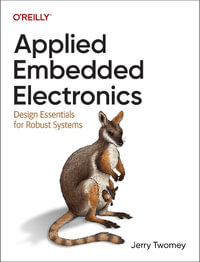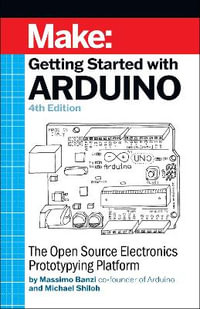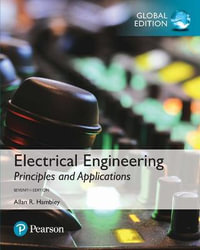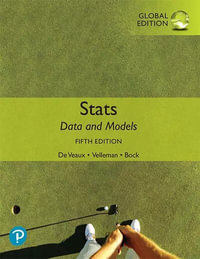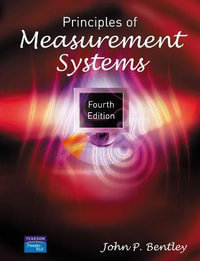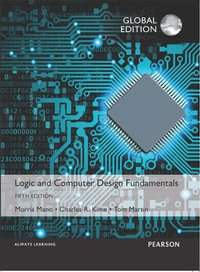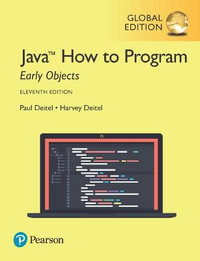| Preface | p. xi |
| The Authors | p. xiii |
| Introduction to Microcontrollers | p. 1 |
| Microprocessors and Microcontrollers: Characterization | p. 1 |
| Components of a Microcontroller | p. 3 |
| The Watchdog | p. 5 |
| Reset Signal | p. 6 |
| Low Consumption | p. 7 |
| Protection against Copying | p. 8 |
| Von Neumann and Harvard Architectures | p. 9 |
| CISC and RISC Architectures | p. 11 |
| Manufacturers of Microcontrollers and Microprocessors | p. 12 |
| PIC Microcontrollers | p. 15 |
| Main Characteristics of PIC Microcontrollers | p. 15 |
| The Arithmetic and Logic Unit (ALU) and the Working Register in PIC Microcontrollers | p. 16 |
| Machine Cycles and Execution of Instructions | p. 17 |
| Pipelining for Instruction Execution | p. 18 |
| Oscillators | p. 19 |
| Configuration Bits | p. 21 |
| Reset Options | p. 22 |
| Low-Power Consumption Mode | p. 27 |
| Watchdog Timer | p. 27 |
| PIC Microcontroller Families | p. 28 |
| Low-End Microcontrollers | p. 29 |
| Medium-End Microcontrollers | p. 30 |
| High-End Microcontrollers | p. 32 |
| Memory in Microcontrollers | p. 39 |
| Basic Concepts | p. 39 |
| Logic Organization of Memory | p. 41 |
| Types of Memory | p. 43 |
| Memory in Medium-End PIC Microcontrollers | p. 44 |
| Program Memory | p. 44 |
| Addressing Program Memory | p. 45 |
| Reading and Writing the Program Memory | p. 47 |
| RAM Data Memory | p. 51 |
| Addressing Data Memory | p. 51 |
| Special Function Registers (SFRs) | p. 54 |
| EEPROM Data Memory | p. 58 |
| Instruction Set and Assembler Language Programming | p. 61 |
| Basic Concepts | p. 61 |
| Machine Code and Assembler Language | p. 61 |
| Structure of Instructions | p. 64 |
| Data Addressing Modes | p. 65 |
| The Stack | p. 67 |
| Instruction Set in Medium-End PIC Microcontrollers | p. 69 |
| Data Transfer Instructions | p. 71 |
| Arithmetic and Logic Instructions | p. 72 |
| Control Transfer Instructions | p. 74 |
| Unconditional Branches, Subroutine Calls, and Returns | p. 74 |
| Conditional Branches | p. 78 |
| Bit Manipulation Instructions | p. 81 |
| Other Instructions | p. 81 |
| Assembler Language Elements (for MPASM Assembler from Microchip) | p. 82 |
| Introduction | p. 82 |
| Expressions, Operations, and Operators | p. 87 |
| Arithmetic Operators | p. 87 |
| Logic and Boolean Operators | p. 89 |
| Logic Operators Using Direct Bit Manipulation | p. 90 |
| Assign Operators | p. 90 |
| Addressing Operators | p. 92 |
| Directives | p. 93 |
| General Use Directives | p. 94 |
| Directives for Relocatable Code | p. 98 |
| Macroinstructions | p. 103 |
| Organization of a Program in Assembler Language | p. 105 |
| Available Resources for Programming PIC Microcontrollers in Assembler Language | p. 110 |
| The MPASM Assembler | p. 111 |
| Absolute Code Generation | p. 112 |
| Relocatable Code Generation | p. 112 |
| Files Used and Generated during the Assembling Process | p. 112 |
| The Linker MPLINK | p. 115 |
| Library Manager MPLIB | p. 117 |
| Parallel Input and Output | p. 121 |
| Basic Concepts | p. 121 |
| Data Transfer Techniques | p. 122 |
| Input/Output Techniques | p. 124 |
| Parallel Ports in Medium-End PIC Microcontrollers | p. 126 |
| Port A | p. 129 |
| Port B | p. 130 |
| Port C | p. 131 |
| Ports D, E, F, and G | p. 131 |
| Parallel Slave Port (PSP) | p. 132 |
| Connection of Commonly Used Peripherals | p. 134 |
| Switches and LEDs | p. 134 |
| Matrix Keypads | p. 138 |
| Seven-Segment LEDs | p. 145 |
| Alphanumeric Liquid-Crystal Displays | p. 148 |
| Timers | p. 157 |
| Timers in PIC Microcontrollers | p. 157 |
| Timer0 Module | p. 157 |
| Timer1 Module | p. 162 |
| Timer2 Module | p. 166 |
| The CCP Module | p. 168 |
| Capture Mode | p. 169 |
| Compare Mode | p. 174 |
| PWM Mode | p. 176 |
| Interrupts | p. 183 |
| Basic Concepts | p. 183 |
| Interrupt Requests and Associated Resources | p. 183 |
| Servicing Interrupt Requests | p. 185 |
| Fixed and Vectored Interrupts | p. 187 |
| Interrupts in PIC Microcontrollers | p. 189 |
| Interrupt Sources and Associated Registers | p. 189 |
| Interrupt Service Subroutine Structure | p. 194 |
| Examples of Interrupt Applications | p. 198 |
| Real-Time Clock | p. 198 |
| Synchronization of Events to Real-Time Clock | p. 202 |
| Protection against Hardware Malfunctions | p. 205 |
| Serial Input and Output | p. 207 |
| Basic Concepts | p. 207 |
| Introduction to Serial Data Transmission | p. 207 |
| Asynchronous Communication | p. 209 |
| Synchronous Communication | p. 209 |
| Connection between Equipment RS-232C Interface | p. 210 |
| The I2C Bus | p. 212 |
| The USART Serial Port in PIC Microcontrollers | p. 216 |
| General Description | p. 217 |
| Asynchronous Mode | p. 217 |
| Synchronous Mode | p. 220 |
| Communication Speed | p. 221 |
| The Synchronous Serial Port in PIC Microcontrollers | p. 223 |
| SPI | p. 223 |
| I2C Interface | p. 228 |
| Analog Input and Output: Signal Acquisition and Distribution | p. 233 |
| Structure of a System for Signal Acquisition and Distribution | p. 233 |
| Basic Functions of Measurement and Control Systems | p. 233 |
| Dynamic Range | p. 236 |
| Bandwidth | p. 238 |
| Signal Sampling | p. 239 |
| Architectures for Signal Acquisition: High-Level and Low-Level Mutiplexing | p. 240 |
| The Front-End in Data Acquisition Systems | p. 242 |
| Attenuators | p. 243 |
| Amplifiers | p. 247 |
| Input Protections and Filters | p. 251 |
| Analog Multiplexers | p. 253 |
| Anti-Alias Filters | p. 255 |
| Sample-and-Hold Amplifier | p. 257 |
| A/D Converters | p. 259 |
| The 10-Bit A/D Converter Module in PIC Microcontrollers | p. 262 |
| Architecture of the Conversion Module | p. 262 |
| A/D Conversion Timing | p. 266 |
| A/D Conversion Module Programming | p. 269 |
| Calibration | p. 271 |
| Direct Sensor-Microcontroller Interface | p. 273 |
| Analog Back-End | p. 276 |
| D/A Converters | p. 276 |
| Analog Demultiplexing | p. 277 |
| Extrapolation Methods | p. 277 |
| PWM Outputs | p. 278 |
| Output Protections | p. 280 |
| Appendix: Acronyms | p. 283 |
| Bibliography | p. 285 |
| Index | p. 287 |
| Table of Contents provided by Ingram. All Rights Reserved. |


